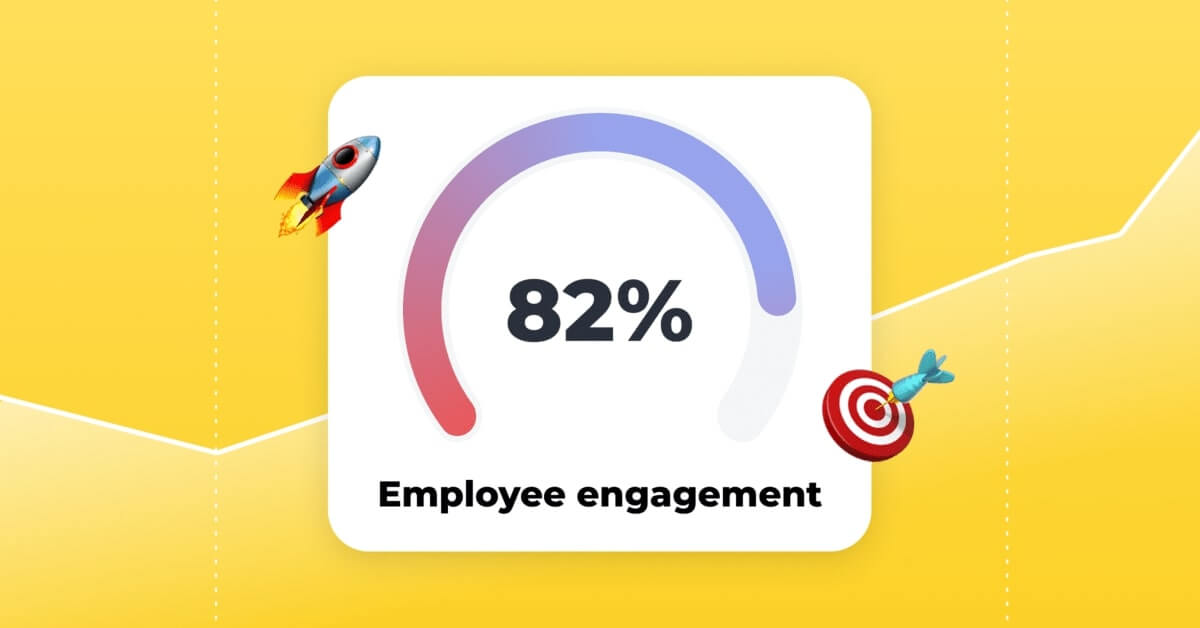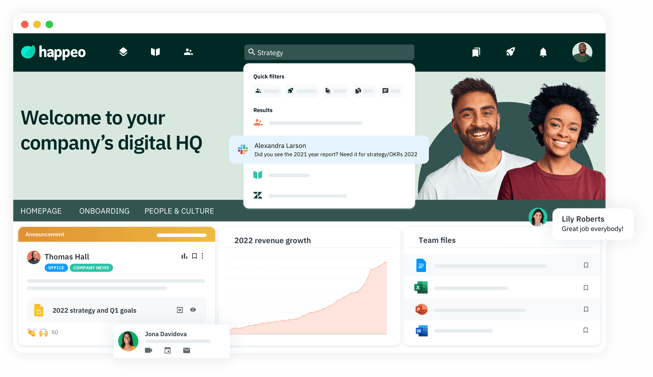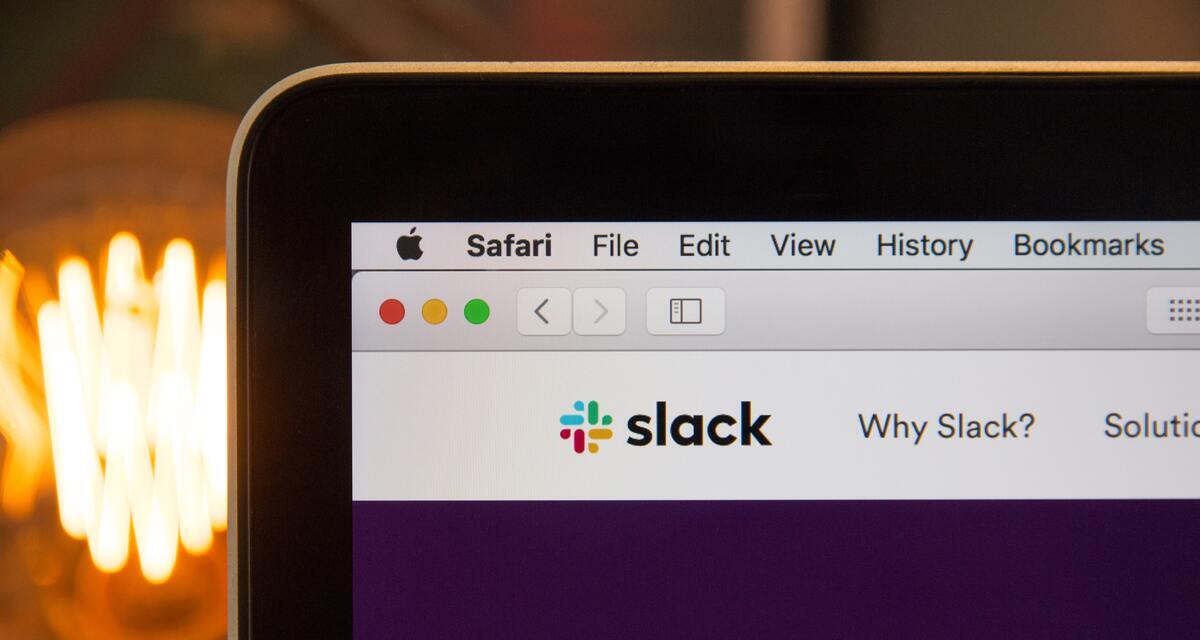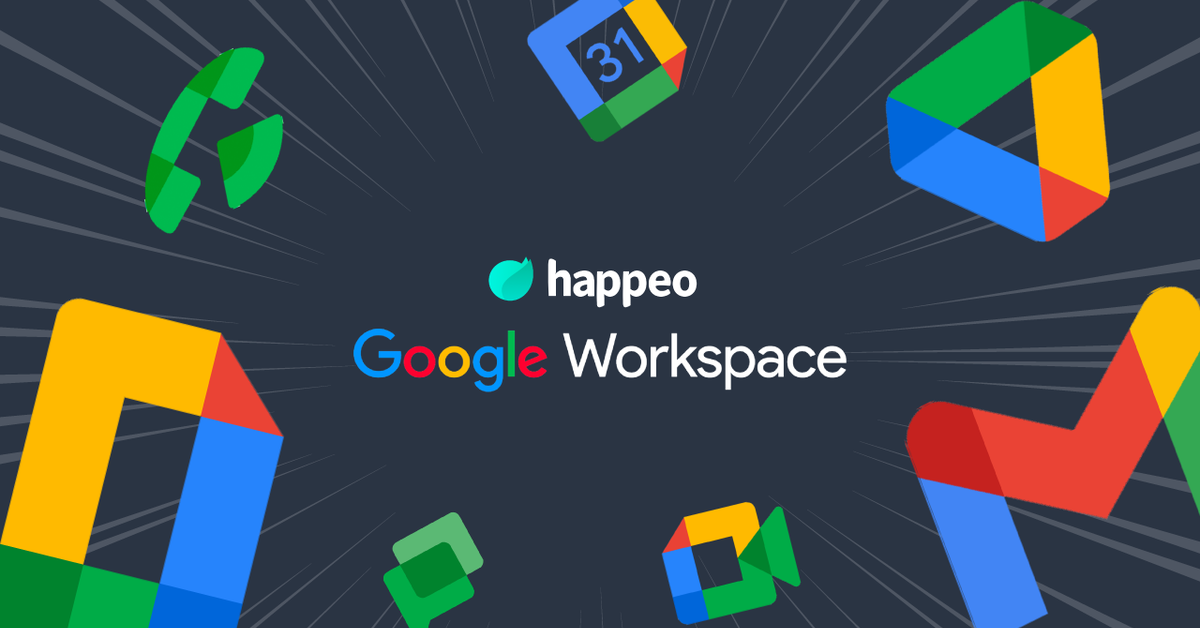

Jonathan Davies
16 mins read
Start building your digital home with Happeo
Request a demoFor more than 12 million people, Slack is where work happens. It’s the first place they go in the morning, and the platform they use to communicate with their colleagues, collaborate on work, and even engage in a bit of (virtual) water cooler chat.
But while it’s undoubtedly a useful tool for communicating remotely in the post-COVID workplace, not everyone is thrilled with Slack.
Think about it: how often have you been caught off guard by that familiar ping just as you’re leaving work for the day, and been dragged into a work conversation that — let’s face it — could have waited until tomorrow?
Slack is also ill-suited for business-critical updates, as noisy channels make it easy for important information to get lost.
All of this means that many companies are looking for Slack alternatives that can help them to streamline their communications, without creating an “always-on” culture that pressures people into working when they’re not at work.
Read on for our discussion of 15 of the best alternatives to Slack for 2024.
What is Slack?
Slack is a workplace communication tool that’s designed to help distributed teams to collaborate in real time. You can use it to send private messages to colleagues, or set up “channels” for specific teams, departments, or projects.
As well as communicating with your internal team, Slack lets you invite external partners and clients to your Slack channel through Slack Connect.
Slack was founded in 2013, and has seen phenomenal growth in the nine years since: as of 2021, over 750,000 organizations worldwide were using Slack.
Why might companies look for alternatives to Slack?
There’s no doubt that Slack is a useful tool, allowing remote and distributed teams to communicate and connect, even from a distance.
But the platform does have some downsides too. Here are a few of the reasons you might be looking for alternatives to Slack in 2024:
Slack can get overwhelming
The incessant pinging of multiple Slack channels is enough to make anyone feel overwhelmed. And, while you can simply log out when you need a break, the instantaneous nature of the platform means many people worry they might miss a piece of information if they do. Research shows that most people check either Slack or their email as much as every six minutes. This means that Slack can be a big productivity suck.
Slack isn't great for knowledge management
When you share a document or a message in Slack, it can easily get lost in the noise. Since there’s no place for static updates, it’s not the right platform for sharing information that people might need to refer to again and again.
Slack doesn't provide deep Workspace integrations
Slack does come with a Google Workspace integration that lets you see comments and other activity on a Drive file directly in a dedicated Slack channel. However, to actually work on your files, you’ll need to leave Slack — which isn’t ideal for productive working. Other solutions let you work on files like Docs, Sheets, and Slides directly within their own interface.
Slack provides limited analytics and reporting
Slack does track basic information like how many messages have been sent, how many files have been uploaded, and which channels are the most popular. However, it lacks any real deep insights into how your teams are using the platform — making it difficult to know if it’s meeting their needs. Other platforms offer more in-depth analytics, giving you info such as the most-searched-for topics and who the main influencers are in each channel.
15 best Slack alternatives and competitors for 2024
Looking for a Slack alternative to try out with your team? We’ve put together 15 of the best alternatives to Slack for 2022 below.
Happeo

Notable brands: Randstad Sourceright, Decathlon, Doctolib, State Auto, OneGoal, Trimble, Mint Dentistry
Rather than alternatives, Happeo and Slack are two different products that complete each other. Since Slack is not an intranet or an Enterprise Social Network (ESN), any communication that lives there has a very short lifespan. And that’s where Happeo jumps in.
While Slack is created to support rapid communication only, Happeo has Pages for static communication, Channels for dynamic communication, and native integration with collaboration tools. So how are Slack and Happeo complementary products? They are deeply integrated with one another to create synergy.
- When you post something in a Happeo Channel it can be directly posted into a connected Slack Channel, and a Slackbot will quickly notify you — asynchronous communication at its finest.
- Happeo and Slack’s Direct-Message (DM) integration allows you to DM your colleagues in Slack from their Happeo profiles.
Key features:
- Universal Search and Federated Search
- Intranet Pages
- Intranet Channels
- Lifecycle management
- Deep Google Workspace and Microsoft 365 integration
- Articles
- Analytics
Pricing: Happeo has three pricing plans: “Essential,” “Recommended,” and “Custom.” The pricing depends on the number of users, as well as the add-ons and features you choose.
Together, Slack and Happeo create synergy
Learn more
Microsoft Teams
Notable brands: Air France, Beiersdorf, TalkTalk, Accenture, Ernst & Young, Pfizer
Teams is a real-time communication platform from Microsoft that’s mostly targeted at enterprise companies. This gives it a slightly more formal feel than Slack, but it’s still a useful program that you can use to chat individually or in groups, and for video calls and conferencing.
Since it’s included with Office 365, it’s a great choice for companies who already use other tools in this suite. However, Teams can be a bit tricky to set up, so it’s not a good solution for organizations without a strong IT function.
Key features:
- Channels
- Private messaging
- Video and audio calls
- Screensharing
- Web, desktop, and mobile app
- Close integration with other Microsoft products
Pricing: Four options from a free plan to $12.50 per user per month, or included with Office 365.
Google Chat
Notable brands (Google Workspace): Salesforce, Colgate-Palmolive, ATB Financial, Atlassian, BBVA
Google Chat is an instant messaging service that’s included in Google Workspace. It works right within Gmail or as a standalone app, and you can use it to chat with anyone with a Gmail account. You can also create “Spaces” to chat with multiple colleagues in the same group.
One of the biggest benefits of using a Google tool is that it’s interconnected with other applications: you can collaborate seamlessly on Docs, Sheets, and Slides, or even send a meeting invitation within a chat window.
Key features:
- Channels
- Private messaging
- Comprehensive search
- Web, desktop, and mobile apps
- Integrated with other Google Workspace apps
Pricing: Google Workspace plans start at 6$ per user per month, going up to 18$ per user per month for the business plan.
Workplace from Meta Groups
Notable brands: Nestlé, Petco, AstraZeneca, Asos, Deliveroo
Workplace is Meta’s offering to the business world, which you can use to create groups for specific teams or projects. You can then use these to share important updates, Q&As, and even files from Google Drive, OneDrive, SharePoint or Dropbox.
Whenever you create a group with fewer than 250 people, you’ll automatically create a group chat as well. This means you can use your group for in-depth discussions and business-critical updates, and only hop on the chat when you need a quick question answered.
Key features:
- Groups
- Comments and post reactions
- Instant chat
- Q&A posts
- Live video broadcasting
- Instant messaging
Pricing: Starts at 4$ per person per month, with a 30-day free trial. You can purchase add-ons for more functionality.
Chanty
Notable brands: Oracle, NASA, Nike, Manchester United, Salesforce
Chanty is a simple chat tool that’s favored by small and medium-sized teams for its clean and simple user interface. It’s similar to Slack in that you can use it to send private messages or communicate in a channel. The platform also has audio and video calling capabilities.
Unlike Slack though, there’s no limit on the number of messages you can send, store, and search (Slack limits searches to the last 10,000 messages). Chanty’s task management feature is also pretty nifty: you can convert any message into a task, assign it to a colleague, and get a notification when they’ve completed it.
Key features:
- Channels
- Private messaging
- Task assignment
- AI-powered search
- Video and audio calls
- screensharing
Pricing: 3$ per user per month, or free for up to ten team members.
Flock
Notable brands: McDonald’s, Tim Hortons, The Times of India, Sodexo, Mother Dairy
Flock is a workplace chat application that comes with productivity tools like to-do lists, notes, and reminders. The interface is fairly intuitive, although its unusual five-column layout can make it seem a bit busy.
Like Slack, Flock caps searchable messages at 10,000 on the freemium version. You can upgrade to unlimited messages on the paid plan, which also comes with other features like screensharing.
Key features:
- Channels
- Private messaging
- Comprehensive message search
- Guest access
- Web, desktop, and mobile apps
Pricing: Free version available for teams of up to 20 people, then $4.50 per user per month for the pro plan.
Convo
Notable brands: H&M, NBC Universal, TechCrunch, The Information Lab
Convo is a workplace communication platform that offers the best of both worlds between synchronous and asynchronous communication. The “chat” feature lets you send quick messages in real time, but more in-depth discussion happens in “comments”. These are longer, threaded conversations that generally involve multiple people. This makes it a great alternative to Slack for distributed teams who may be working across different time zones.
Key features:
- Threaded conversations
- Private messaging
- Content feed
- Video calls
- 700+ integrations
Pricing: Free plan available for teams of up to 10 people, or $6.67 per user per month. There’s also an enterprise plan available for larger businesses.
RocketChat
Notable brands: Audi Business Innovation, SeekingAlpha, OnShore Security, Gluu
RocketChat is the world’s largest open-source communication platform. You can customize its look and feel to your liking, and choose from self-hosted, air-gapped, or cloud-based deployment to make sure it meets your security needs too.
It’s super easy to migrate to RocketChat by importing data downloaded from Slack or HipChat, and the live translation feature means you can chat with your colleagues around the world without any awkwardness.
Key features:
- Channels for group collaboration
- Private messaging
- Comprehensive search
- Video and audio calls
- Real-time translation
Pricing: Free plan or 3€ per user per month. There’s an enterprise plan available for larger teams.
Troop Messenger
Like Slack, Troop Messenger offers private and group chats. It also comes with several interesting features that make it a good alternative to Slack.
For example, the “respond later” function means you can hit a button when you don’t have time to reply to a message and it’ll disappear, popping back up at a more convenient time. The burnout mode creates a private conversation with messages that are automatically deleted after a set period.
Key features:
- Group chats
- Private messages
- Video and audio calls
- Screensharing
- Task management
- Auto-deleting messages for privacy
Pricing: Starts at $2.50 per user per month, and goes up to 9$ per user per month for the enterprise plan.
RingCentral Glip
Notable brands (RingCentral): San Francisco Symphony, Lush Cosmetics, Texas Christian University, Bennett International
Glip is a collaboration tool built by RingCentral, offering private and group conversations. You can also use the chat with yourself to send notes, links, and reminders — a Slack feature that many people find useful.
The platform also includes team calendars and task management features — but if you want to use video calls, you’ll have to download a separate piece of software from RingCentral, which could be offputting for some people.
Key features:
- Private messaging
- Group channels
- Task management features
- Videoconferencing (through RingCentral)
- Shared calendars
Pricing: Free plan available for up to 100 people.
Ryver
Notable brands: Efficio, Dignity Health, Crypto Valley Association, Armor
Ryver is a team communication tool that’s known for its in-built task management features, which make it a sort of crossover between Slack and Trello.
Ryver allows for public forum discussions, group chats, and private messaging. Within chats, you can create “topics”, which are similar to threads in Slack. The platform also comes with videoconferencing for up to five people.
Key features:
- Forums for group conversations
- Private messaging
- Comprehensive message search
- Workflow automation tools
- Video and audio calls
- Web, desktop, and mobile apps
Pricing: Starts at $69 per month for up to 12 users, going up to $129 per month for up to 30 users. For more than 30 users, you’ll pay an extra $4.67 per user per month, or opt for the enterprise plan.
Cisco Jabber
Notable brands: Airbus, Manpower Group, Wayfair, Hiscox
Jabber is a tool from Cisco that combines IM, calls, videoconferencing, and desktop sharing in one platform. You can use it on your desktop or phone, and can even forward calls to your desk phone when you’re in the office.
You can also use real-time presence information to make sure you only call people when they’re available, and leave them a voicemail if not.
Key features:
- Instant messaging
- Voice and video calls
- Screensharing
- Search feature
- Mobile and desktop applications
Twist
Notable brands: Headstart, Remote-How, Microverse, Learning Ally, Geeky Medics
Twist is a communication platform designed for the asynchronous work model. Instant one-on-one and group chats are available for when you need a quick answer, but that’s not the focus here.
Instead, most conversations are organized into threads. This reduces clutter and means that people only need to be aware of the conversations that are relevant to them.
Key features:
- Private messages
- Channels
- Comprehensive search functionality
- Web, desktop, and mobile apps
- Video and audio calls (via integrations)
- Integrates with Todoist for task management
Pricing: Free plan for up to 500 members, or 5$ per user per month.
Mattermost
Notable brands: U.S. Air Force, Bosch, Samsung, DuckDuckGo, NASA
Mattermost is an open-source platform designed for collaboration between developers. It’s highly customizable, and you can integrate it with the tools you already use thanks to a range of APIs and plugins.
Like Slack, Mattermost lets you send private direct messages or communicate in public channels. It also comes with a Kanban-style project management feature, secure audio calls, screensharing, and file sharing.
Key features:
- Public channels
- Private direct messages
- Mobile app
- Announcements
- File sharing
Pricing: Free plan for single teams (no user limit), or $10 per user per month for the pro plan. There’s also an enterprise plan for larger organizations.
Wire
Notable brands: Apololab, Fortum, Genua, Wigger
Wire is a secure communication platform that provides end-to-end encrypted group chats, audio calls, video conferences, and screensharing. It’s a good alternative to Slack if you want to be sure your data is safe. For this reason, Mattermost pitches itself as a Slack alternative for government departments and other organizations with a strong focus on security.
Key features:
- Private messaging
- Group conversations
- Self-destruct messages
- Audio and video calls
- Sketch image editing
Pricing: The basic plan is free to up to five users, or $7.65 per user per month for the enterprise plan. Contact Wire for pricing details for government organizations.
Choose the best Slack alternative for your business
Every Slack alternative on this list comes with its own unique feature set, and you need to be sure that the solution you choose will work for your organization.
That said, there are a few things you shouldn’t compromise on. Here are a few key considerations to keep in mind when you’re comparing alternatives to Slack:
- Easy-to-use: Look for tools with a clean and pleasant interface that your teams will actually enjoy using.
- Advanced search functionality: To make sure everyone has access to the information they need, look for tools with strong search capabilities — even better if they can simultaneously search across multiple platforms.
- Collaboration baked into the platform: Features like team Channels and in-app editing of Google Drive files can help to make collaboration easier.
- Enables Internal Communication: Easy to use channels, integrations with the communication tools you use already, and a mobile app to ensure people can connect on the go are all useful features to look for.
- Integrates with your existing stack: Look for solutions with integrations with popular tools like Google Workspace or Microsoft 365, or other tools your team already uses.
Slack has revolutionized the way we work. Firing a quick question to a colleague is now even easier than walking over to their desk — even when they’re thousands of miles away.
However, it’s only designed for communications with a very short lifespan. You can get the best of both worlds by combining Slack’s instant connection with Happeo’s powerful knowledge management, collaboration, and social intranet features.
Interested? Book a free demo call with a Happeo expert to learn more.



